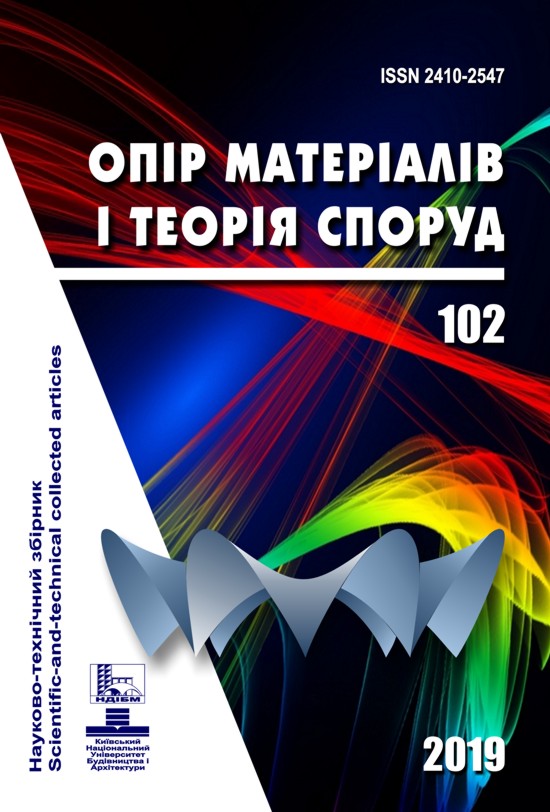The change of air permeability of concrete in time
DOI:
https://doi.org/10.32347/2410-2547.2019.102.25-36Keywords:
nuclear power plant, concrete, air permeability, structure, cement stoneAbstract
The air permeability of heavy concrete is an important indicator and its value is normalized with the application of concrete in protective shells of nuclear power plants. The critical value of the air permeability index of concrete is determined from the condition of the permissible velocity of air flowing through the shell in the design basis accident. Today, this value is achieved mainly due to constructive solutions in the design of the protective shell.The article presents the results of research on the compliance of concrete with the established requirements for its air permeability for a comprehensive justification for further safe operation of nuclear power plants for 25 years after the achievement of the project life (30 years).To obtain the necessary indicators for calculations, a model composition of concrete was designed so that it corresponded to real concrete of nuclear power plant protective shells from which the specimens were made. A comparative study of air permeability of concrete at different age were made, such as concrete at the age of 28 days simulating the composition of concrete used in the construction of the nuclear power plant, and concrete at the age of 35 years selected from the protective shell of the nuclear power plant.The air permeability of concrete at the age of 28 days does not meet the requirements of safe operation of nuclear power plants. At the same time, it was established that concrete selected from the protective shell, meets the requirements for the safety of operation of the nuclear power plants. The obtained results are explained by the processes of compacting the concrete in time.References
Krivenko P.V., Pushkarova K.K. and other. (2008) Budivelne materialoznavstvo (Building Material Science): Pidruchnyk dlia studentiv vyshchikh navchalnykh zakladiv. Kyiv. 690.
Osman Wasfi, Mohammed Imbadi. (2017). Experimental evolution of the properties of lightweight breathable concretes. Journal Advances in Applied Ceramics. Volume 116. Issue 4: Cement Concrete Science. – Р. 225-229.
Runova R.F., Sheinich L.O. and other. (2002). Osnovy vyrobnytstva stinovykh ta ozdobliuvalnykh materialiv (Basis of production the materials for wall and finishing). Kyiv. 368 p.
Ukazanija po podboru sostavov I kontroliu kachestva gazonepronicaemykh betonov dlia zashchity sooruzhenii atomnykh elektrostancii (Uidelines for the selection of compositions and quality control of gas-tight concretes to protect the structures of nuclear power plants). (1991). Кyiv. NIISK. – 48 p.
Farenyuk E.G., Postol A.S. (2017). Eksperymentalnyi analiz povitropronyknosti fasadnykh system z povitrianym prosharkom (Experimental analysis of air permeability of air-layer facade systems). Nauka I budivnytstvo, №1 (11). – P. 10-14.
Wong J.M., Glasser F. , Imbabi M. (2005). Breathable concrete for low energy buildings, Conference: WREC, At Aberdeen, Scotland (UK). Retrieved from https://www.researchgate.net/publication/270282868 Breathable concrete for low energy buildings.
Dhir R.K., Hewlett P.C., Chan Y.N. (1989). Near surface characteristics of concrete: intrinsic permeability. Magazine of Concrete Research. ISSN 0024-9831. E-ISSN 1751-763X Volume 41 Issue 147, 87-97.
Luis Ebensperger, Roberto Torren. (2010). Concrete air permeability "in situ" test status quo. Revista Ingeniería de Construcción Vol. 25 N°3, 371-382.
ATTMA. (2015). Air permeability testing. Retrieved from https://www.designingbuildings.co.uk/wiki/Air_permeability_testing .
Dorofeev V.S., Vyrovoi V.N. (1998). Tekhnologicheskaia povrezhdennost stroitelnykh materialov i konstruktsii (Technological damage to building materials and structures). – Odessa: Gorod masterov. – 168 p.
Sopov V.P., Reshetniak L.N., Zhdaniuk N.I. (2007). Aktivnye i neaktivnye pory v betone (Active and inactive pores in concrete). Sbornik trudov ІХ Mezhdunarodnaia nauchno-prakticheskaia konferentsiia “Budindusriia LTD”, Zaporizhzhia. – P. 163-168.
Sheinich L.O., Pushkarova K.K. (2009). Protsesi samoorganizatsii struktury stroitelnykh kompozitov (The processes of self-organization of the structure of building composites). – K.: Gamma-Print. 146 p.
Md. Safiuddin. (2017). Concrete Damage in Field Conditions and Protective Sealer and Coating Systems. 7(7), 90. doi:10.3390/coatings7070090
K. Hornbostel, C. K. Larsen, M. R. Geiker. (2013). Relationship between concrete resistivity and corrosion rate – A literature review. Cement and Concrete Composites. Vol. 39. 60–72. doi: 10.1016/j.cemconcomp.2013.03.019
K. Celik, C. Meral, A. Petek Gursel, P.K. Mehta, A. Horvath, P.J.M. Monteiro (2015). Mechanical properties, durability, and life–cycle assessment of self–consolidating concrete mixtures made with blended portland cements containing fly ash and limestone powder. Cement and Concrete Composites. Vol. 56. 59–72. doi: 10.1016/j.cemconcomp.2014.11.003
Tongji Daxue Xuebao. (2009). Еffect of permeability оf concrete аnd air entrainment оn durability of concrete. // Journal of Тongji university 37(6). – P. 744-748.
Berg O.Ia. (1974). Fizicheskie osnovy teorii prochnosti betona I zhelezobetona (Physical basis of the theory of strength of concrete and reinforced concrete). Мoskva, Stroiizdat. 95 p.
Stefanov B.V., Rusanova N.G., Volianskii A.A. (1982). Tekhnologiia betonnykh I zhelezobetonnykh izdelii (Concrete and reinforced concrete products technology). Kyiv, «Vyshcha shkola». 406 p.
Hailong Wang, Xiaoyan Sun, Junjie Wang & Paulo J.M. Monteiro. (2016). Permeability of Concrete with Recycled Concrete Aggregate and Pozzolanic Materials under Stress. Journal List Materials (Basel) v.9(4); Apr PMC5502916.
Nikolova B., Taucer F., Mazars J. (2014). Control of cracking and durability of reinforced concrete structures. 4th ConCrack workshop “Engineering and Standard issues, 80. doi:10.2788/1999.
Downloads
Published
Issue
Section
License
Authors retain copyright and grant the journal right of first publication with the work simultaneously licensed under a Creative Commons Attribution License that allows others to share the work with an acknowledgement of the work's authorship and initial publication in this journal.

